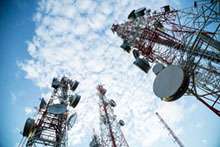Transmitting wireless data on higher frequencies

Everything we do that requires a wireless connection uses the radio spectrum. We're able to harness radio waves to listen to music in the car or stream Netflix from the 4G network on our smartphones. Each application is assigned its own frequency within the spectrum. The problem is that space is limited and our demand is only increasing. But what if we weren't bound by this crowded spectrum?
The radio spectrum exists on the lower end of the larger electromagnetic spectrum. As you move up the spectrum into microwaves, infrared, visible and ultraviolet light, x-rays and gamma rays, the wavelengths get shorter and their frequency gets higher and higher. Associate Professor Cenk Gursoy of the College of Engineering and Computer Science sees potential in using higher frequencies for wireless services in something called the "millimeter wave frequency band," for the primary purpose of allocating more bandwidth to deliver faster, higher-quality video and multimedia content.
Gursoy explains, "The millimeter band is a much broader spectrum and, given the spectrum crunch we are experiencing, we should have already moved there. But there are certain challenges. We intend to look at the challenges and develop solutions to deal with them to move into these higher frequencies."
The challenges he mentions will not be easily overcome. Substantial research is needed to make this a reality. To start, we don't have the right equipment for this. New, smaller, adaptive antennas need to be designed for our mobile devices to receive these higher frequency waves. Additionally, while radio waves propagate in a way that can be received over great distances and through weather and structures, millimeter waves require a line-of-sight connection between the transmitting and receiving antennas to work well. Buildings, rain and even the position of a user's hand on their device can block these shorter wavelengths or have significant impact on the quality of their reception. Attenuation is also a concern. Millimeter waves simply don't travel the same distances as radio waves.
Gursoy and principle investigators at Ohio State University received an award from the National Science Foundation to address these challenges as part of the foundation's Enhancing Access to the Radio Spectrum (EARS) collaborative research program. Their work will take place over the next three years. The work that Gursoy will be completing at Syracuse University will explore ways to address the line-of-sight and attenuation issues to integrate the use of millimeter waves through modeling.
"By the end of the third year, we will have a good understanding of the limits and what can be done to make this a reality. It's something that the wireless industry clearly has a vested interest in, so we should see millimeter waves incorporated into things like the upcoming 5G network very soon. If it's really as promising as it looks, then we should see many products using this by 2020 or earlier," says Gursoy. "Everyone connected to the project is learning more and it's exciting because it's something that very few people are working on and it's happening here at SU."
Provided by Syracuse University














.jpg)





